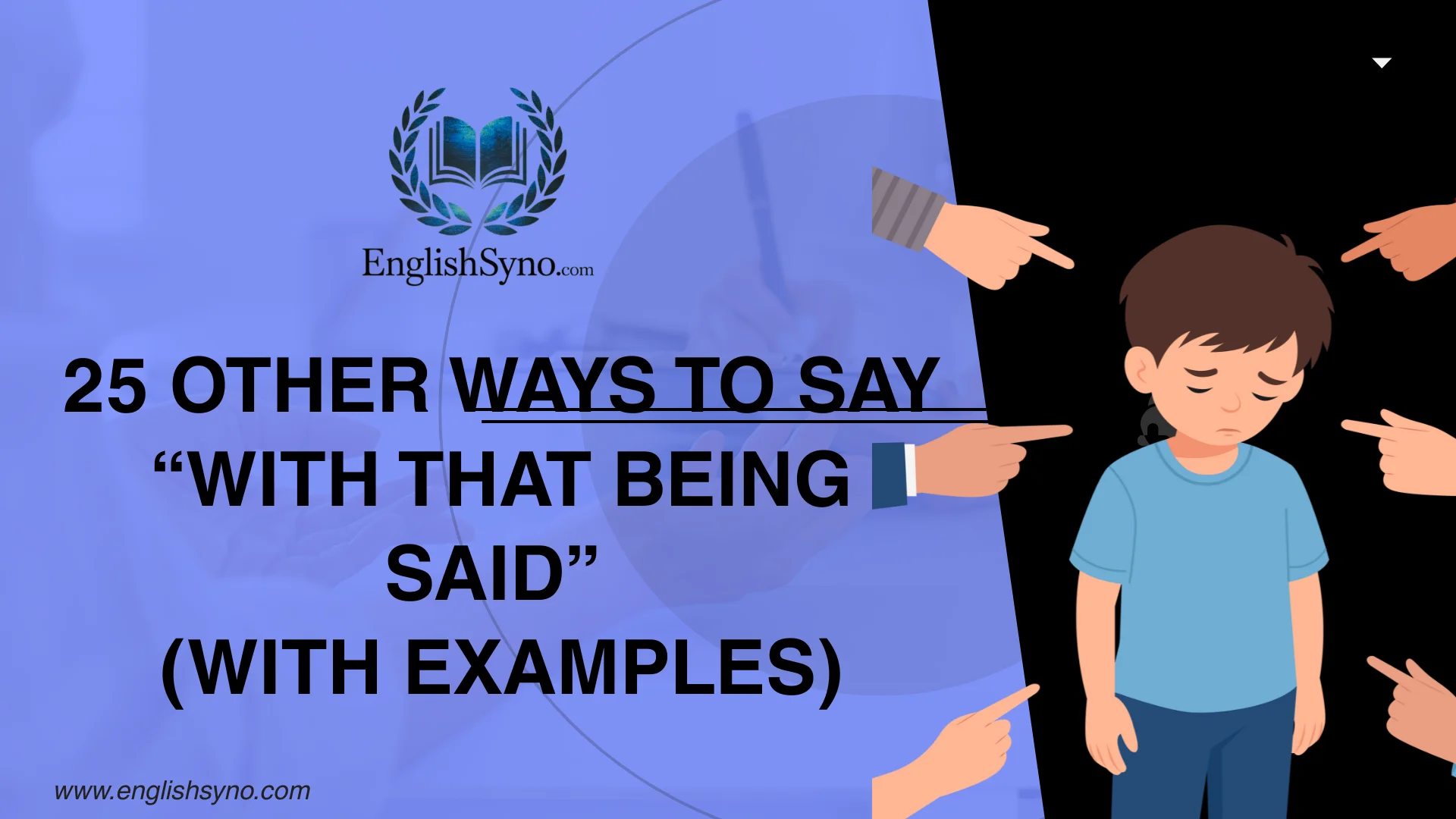The idiomatic phrase “with that being said” beautifully helps introduce a contrasting or qualifying statement that slightly modifies or even contradicts a previous point. From my writing and conversations, I’ve learned how it keeps a smooth balance between honesty and diplomacy, serving as one of those transition words, like however, but, or that gracefully shift direction without breaking the flow of thought or intent.
It naturally indicates that while a preceding idea might be true, the following thought remains valid and relevant. When sharing feedback, I often say, “Your proposal is strong; with that being said, we can refine a few details.” Such phrasing feels respectful, clear, and bridges ideas like a gentle linguistic link, softening tone while maintaining communication that’s both thoughtful and precise.
What Does “With That Being Said” Mean?
The phrase “with that being said” is an idiomatic expression used to introduce a contrasting or qualifying statement. It means you’re acknowledging what was just mentioned while adding something that either balances, clarifies, or slightly contradicts the earlier point.
It’s often used in both formal and casual communication to show that you are considerate, thoughtful, and diplomatic in your speech or writing.
When to Use “With That Being Said”
You can use “with that being said” when you need to:
- Transition smoothly between two contrasting ideas
- Acknowledge a point while offering a new perspective
- Deliver feedback or critique politely
- Move from agreement to a differing opinion
Example:
“Your project idea is excellent. With that being said, we may need to adjust the timeline slightly.”
Is It Professional/Polite to Say “With That Being Said”?
Yes, “with that being said” is both professional and polite. It helps maintain respect and clarity even when disagreeing or providing constructive feedback. It’s commonly used in emails, meetings, and presentations to make your tone sound more balanced and empathetic.
Pros or Cons
Pros:
- Adds warmth and respect to a transition
- Keeps the tone polite and non-confrontational
- Works in both spoken and written English
Cons:
- Can sound repetitive or overly formal if overused
- Sometimes slows down the flow of conversation
However
Meaning: Used to introduce a statement that contrasts with or seems to contradict something previously said.
Detailed Explanation: “However” is concise and academic, perfect for formal communication.
Example Email:
“Your proposal is thorough and well-structured. However, the budget needs adjustment before final approval.”
Best Use: Professional emails, academic writing
Worst Use: Casual texting-it might sound too stiff
Tone: Formal, respectful
But
Meaning: A simple conjunction that introduces a contrast.
Detailed Explanation: “But” is one of the most versatile transition words, easily fitting into casual or professional contexts.
Example Email:
“I love your idea, but we’ll need to discuss the timeline further.”
Best Use: Everyday speech and informal writing
Worst Use: In overly formal documents
Tone: Neutral, conversational
Nevertheless
Meaning: Expresses contrast while maintaining acknowledgment of a previous statement.
Detailed Explanation: It adds sophistication and works beautifully in formal or persuasive writing.
Example Email:
“The results were below expectations; nevertheless, your efforts were commendable.”
Best Use: Professional, persuasive, or motivational writing
Worst Use: Very casual messages
Tone: Formal, encouraging
Still
Meaning: Indicates persistence or continuation despite something.
Detailed Explanation: It’s short, effective, and shows gentle contrast.
Example Email:
“We faced several challenges; still, the project remains on schedule.”
Best Use: Neutral to professional communication
Worst Use: Highly formal academic writing
Tone: Calm, steady
Even so
Meaning: Used when something is true despite what was said before.
Detailed Explanation: Adds a reflective, understanding tone.
Example Email:
“It’s been a tough quarter; even so, our team has made meaningful progress.”
Best Use: Emails, speeches, or reports
Worst Use: Text messages
Tone: Reflective, respectful
That Said
Meaning: A shortened form of “with that being said.”
Detailed Explanation: More casual but equally polite.
Example Email:
“Your proposal looks strong. That said, we might tweak a few points for clarity.”
Best Use: Business and casual writing
Worst Use: Formal academic papers
Tone: Conversational, balanced
All the same
Meaning: Indicates that something remains true despite a previous statement.
Detailed Explanation: Often used to soften a differing opinion.
Example Email:
“It’s not an urgent task, all the same, it would be wise to complete it soon.”
Best Use: Polite disagreement
Worst Use: Corporate reports
Tone: Gentle, respectful
Regardless
Meaning: Used when an action continues despite circumstances.
Detailed Explanation: Conveys determination and resolve.
Example Email:
“The meeting was delayed; regardless, we’ll submit the report on time.”
Best Use: Determined, solution-oriented contexts
Worst Use: Emotional or sensitive messages
Tone: Firm, professional
In any case
Meaning: Used to introduce a new statement that remains true despite previous ones.
Detailed Explanation: Adds closure or transition naturally.
Example Email:
“There were a few issues; in any case, the launch went smoothly.”
Best Use: Summarizing or redirecting discussions
Worst Use: Legal or academic writing
Tone: Casual, positive
Even though
Meaning: Connects two ideas showing contrast or concession.
Detailed Explanation: It’s empathetic and sounds sincere.
Example Email:
“Even though we faced delays, your persistence made a huge difference.”
Best Use: Expressing empathy
Worst Use: Business proposals
Tone: Kind, human
Nonetheless
Meaning: Used to show contrast while accepting a previous point as true.
Detailed Explanation: “Nonetheless” keeps your tone diplomatic while expressing a shift or contradiction. It’s often used to show persistence or steady confidence.
Example Email:
“Your approach is unconventional; nonetheless, it’s creative and worth exploring.”
Best Use: Business emails, reports, or presentations
Worst Use: Informal chats or casual messages
Tone: Professional, composed
Even then
Meaning: Indicates that something remains true despite another situation or fact.
Detailed Explanation: “Even then” adds emphasis to perseverance or consistency in reasoning.
Example Email:
“We missed some deadlines. Even then, our results exceeded expectations.”
Best Use: Motivational messages, performance reviews
Worst Use: Technical documents
Tone: Reassuring, reflective
Having said that
Meaning: A conversational equivalent of “with that being said.”
Detailed Explanation: Natural and versatile, it fits both casual and formal tones.
Example Email:
“You’ve done a fantastic job. Having said that, there’s room to refine a few sections.”
Best Use: Everyday speech, emails, meetings
Worst Use: Academic writing
Tone: Balanced, conversational
On the other hand
Meaning: Introduces a different perspective or consideration.
Detailed Explanation: Commonly used in arguments or comparisons to show contrast clearly.
Example Email:
“We could launch early to gain attention. On the other hand, waiting ensures better preparation.”
Best Use: Business strategy, discussions
Worst Use: Emotional or personal writing
Tone: Analytical, neutral
Even after that
Meaning: Expresses continuation despite something happening before.
Detailed Explanation: Shows persistence or resilience in tone.
Example Email:
“We faced challenges in Q1; even after that, our sales improved steadily.”
Best Use: Reports, reflective writing
Worst Use: Highly formal or academic content
Tone: Optimistic, steady
At the same time
Meaning: Used to balance two ideas or highlight parallel truths.
Detailed Explanation: Ideal for acknowledging multiple sides of a situation politely.
Example Email:
“Your suggestions are practical. At the same time, we should consider budget limits.”
Best Use: Diplomatic or teamwork settings
Worst Use: Emotional or romantic writing
Tone: Neutral, collaborative
Be that as it may
Meaning: A formal way of saying “even so” or “nonetheless.”
Detailed Explanation: Polite and old-fashioned, it adds authority to formal statements.
Example Email:
“We’ve had delays; be that as it may, the overall performance was strong.”
Best Use: Legal, academic, or executive communication
Worst Use: Informal texting
Tone: Formal, authoritative
Even then so
Meaning: Expresses contrast while maintaining understanding of the prior statement.
Detailed Explanation: Often used to emphasize resilience or optimism despite conditions.
Example Email:
“Our budget is tight; even then, the quality must remain high.”
Best Use: Motivational speech or internal communication
Worst Use: Casual messages
Tone: Positive, determined
After all
Meaning: Used to add reasoning or justification that reinforces your point.
Detailed Explanation: Makes your tone sound natural and relatable.
Example Email:
“Let’s keep the original plan; after all, it aligns best with our goals.”
Best Use: Persuasive or explanatory communication
Worst Use: Overly formal settings
Tone: Friendly, reasoning
In spite of that
Meaning: Means “despite what has been said or done.”
Detailed Explanation: A humble and considerate way to contrast situations.
Example Email:
“The forecast was uncertain; in spite of that, we achieved success.”
Best Use: Reviews, updates, or reflective writing
Worst Use: Informal chats
Tone: Hopeful, composed
Yet
Meaning: Simple and powerful, “yet” implies contrast or exception.
Detailed Explanation: Great for short, impactful sentences.
Example Email:
“The plan was ambitious, yet it worked flawlessly.”
Best Use: Professional summaries or strong conclusions
Worst Use: Very casual writing
Tone: Confident, concise
Still and all
Meaning: An idiom meaning “nevertheless” or “despite that.”
Detailed Explanation: Old-fashioned but warm, it adds depth to emotional writing.
Example Email:
“We lost a client; still and all, the team showed remarkable spirit.”
Best Use: Personal letters, reflective notes
Worst Use: Modern corporate settings
Tone: Sentimental, gentle
Even after saying that
Meaning: A phrase indicating that the previous point remains acknowledged despite what follows.
Detailed Explanation: Ideal for expressing polite disagreement or revision.
Example Email:
“I appreciate your feedback. Even after saying that, I believe our method is effective.”
Best Use: Polite rebuttals, professional discussions
Worst Use: Casual conversations
Tone: Respectful, diplomatic
Despite that
Meaning: A concise expression showing opposition or resilience.
Detailed Explanation: Common in both business and personal writing.
Example Email:
“The feedback was harsh; despite that, your progress is evident.”
Best Use: Professional feedback, self-reflection
Worst Use: Informal text or chat
Tone: Balanced, constructive
In light of that
Meaning: Used to introduce a decision or perspective based on a previous statement.
Detailed Explanation: Connects cause and consequence smoothly.
Example Email:
“The market has shifted; in light of that, we’ll revise our approach.”
Best Use: Decision-making, planning discussions
Worst Use: Casual writing
Tone: Thoughtful, professional
Final Thoughts
With that being said, finding better ways to express yourself isn’t just about vocabulary-it’s about connection, clarity, and care. Using thoughtful alternatives to this phrase helps your communication feel more authentic, empathetic, and professional. Whether you’re writing an email, leading a meeting, or having a heartfelt conversation, choosing the right words makes your message sound more natural and engaging. Phrases like “that said,” “nevertheless,” “on the other hand,” or “in light of that” keep your tone balanced while showing emotional intelligence.
As someone who values meaningful communication, I’ve found that small language shifts can deeply influence how people respond. Instead of relying on one familiar expression, experimenting with different ways to transition between ideas encourages variety and depth. These alternatives also reflect awareness-showing that you care about how you say things, not just what you say. Ultimately, being mindful of your phrasing builds trust, warmth, and understanding, no matter the setting.
FAQs
What does “with that being said” mean?
It means acknowledging a previous statement while introducing a contrasting or clarifying point.
Is “with that being said” formal or casual?
It’s versatile-appropriate for both formal and conversational communication.
What are professional alternatives to “with that being said”?
Try “however,” “nonetheless,” “that said,” or “in light of that.”
Can I use “with that being said” in an email?
Yes, it’s ideal for transitioning politely between ideas.
Is it grammatically correct to say “with that being said”?
Yes, it’s a correct idiomatic expression.
What’s the difference between “however” and “with that being said”?
“However” is more formal and direct; “with that being said” feels softer and conversational.
Why do people use “with that being said”?
It helps express contrast or add balance in a polite, structured way.
What are informal alternatives?
Use “that said,” “still,” or “even so” for relaxed tone transitions.
Is it overused in writing?
Sometimes-diversifying your expressions keeps your writing engaging.
Can it start a sentence?
Yes, it’s commonly used at the beginning of sentences to shift tone or idea.
How can I replace it in speeches?
Use “moving forward,” “on another note,” or “still” for smoother verbal flow.
Does it work in academic writing?
It’s acceptable, but “however” or “nevertheless” are often better choices.
Can “with that being said” make writing sound polite?
Absolutely softens transitions and conveys respect.
Should I avoid it in emails?
Not necessarily-just vary your phrasing for better engagement.
Why learn alternatives to “with that being said”?
Using alternatives shows versatility, emotional awareness, and refined communication skills that connect better with your audience.



